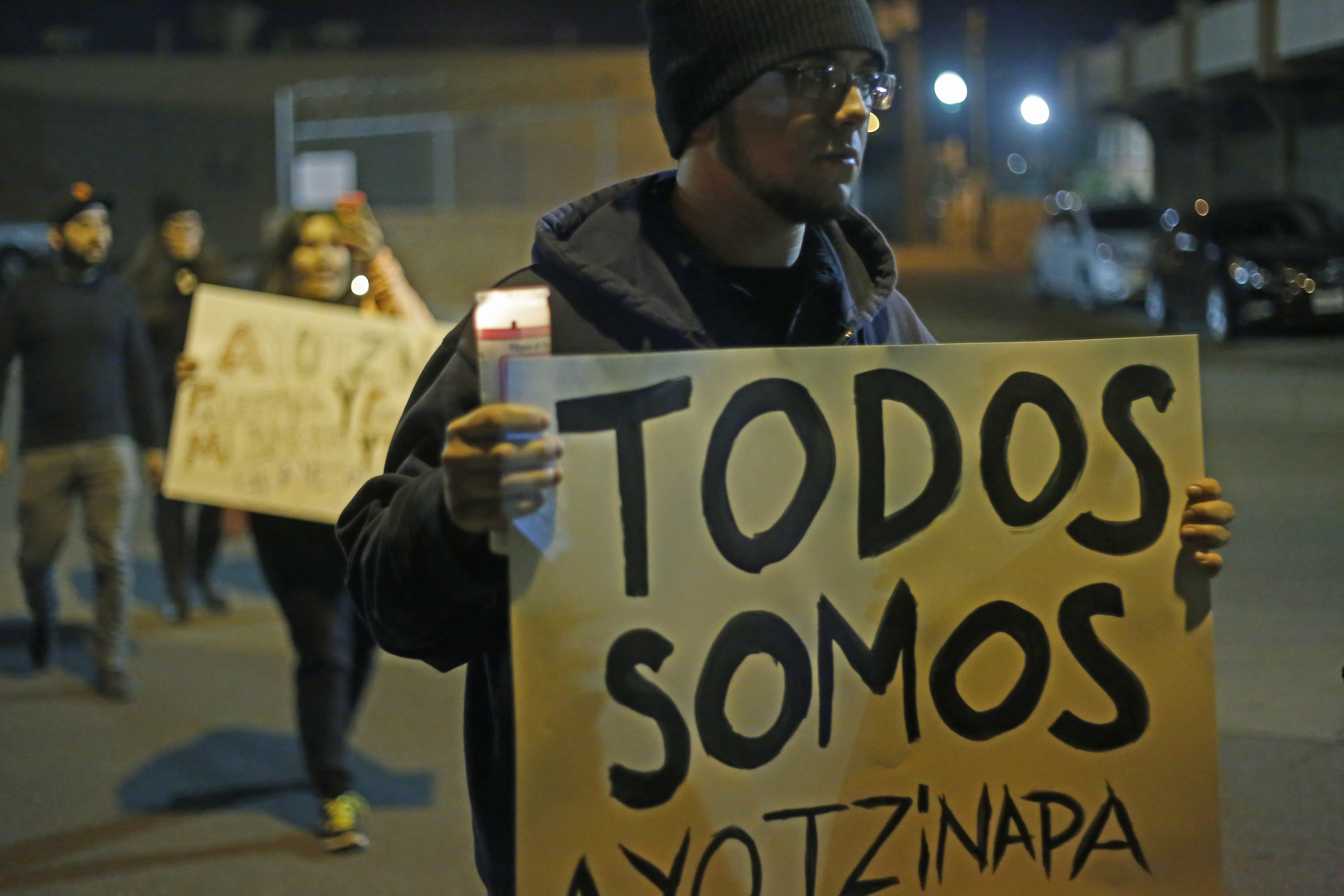EL PASO—With their fists raised in mid-air, more than 80 persons including students, and teachers, marched through downtown streets shouting out against the kidnapping and suspected killing of Mexican students in Ayotzinapa in the state of Guerrero.
They started the march Friday, November 21,at the University of Texas at El Paso, ending at the main doors of the Mexican consulate. “Who has the leadership, the students or the government that killed them!” they shouted.
Photo gallery: El Paso march, vigil demands justice for Mexican students
En español: Marcha en El Paso da grito de apoyo a Ayotzinapa
Voces / Commentary: Condenan en El Paso la muerte de los estudiantes y la corrupción en México
Different groups gathered in this march. The students came from the organizations Ayotzinapa Sin Fronteras and the Master of Social Work Student Organization. Centro Sin Fronteras and M.E.Ch.A del Chuco were local groups that joined the protest.
This last group helped the students set up an exhibition outside the Liberal Arts Building at UTEP. It consisted of six rows of metal chairs, with a photo and brief description of one of the 43 missing students attached to each chair.
Part of a global movement
The program was organized by Accion Global por Ayotzinapa, an international network of support for the 43 students that were allegedly kidnapped by government officials.
Monterrey, Guanajuato, and Nuevo Leon were some of the many cities in Mexico that joined this global protest movement. New York, Iowa, and Los Angeles, just to mention a few, were the cities that showed international support and awareness for Ayotzinapa.
George Dagda, a student from UTEP and leader of the group El Paso por Ayotzinapa, said he is angered by the current state his country is living through.
“I think that with these 43 missing students people had enough. The world doesn’t want to see any more violence but a change in Mexico, both cultural and political,” said Dagda.
Guillermo Glenn, organizer of one of the local groups and a worker from Union del Pueblo Fronterizo, believes that it is crucial to have and show support in the border region.
“This is very important for Mexican people that reside on both sides of the border. I believe that with this sacrifice we can create change,” said Glenn.
Echoes of earlier injustice
This is not the first time that Mexico experienced an event where students are victims. In 1968 the government and the Mexican army killed more than 300 students at the University Of Tlatelolco (UNAM). That was considered part of the “Dirty War” of Mexico, when the government would use all of its political power to control dissent.
Today Mexican citizens remember that day of 1968.
“These marches are very important for all students. They have always taken the lead such as when the tragedy in Tlatelolco happened,” said Glenn.
Fear of government corruption
The march here came to a brief stop outside the office of Congressman Beto O’Rourke (D—El Paso) to explain and protest the Merida Initiative, a plan in which both the U.S. and Mexico joined forces to fight against violence.
Opponents of the initiative say it is putting weapons and ammunition in the hands of corrupt government agencies in Mexico.
“I believe that is important to accuse the U.S. government in all aspects. We have to demand for this corrupt plan to come to an end,” said Selfa Chew, social activist and history professor at UTEP. “The future of this movement depends a lot on the government.”
In a speech delivered on the steps of the Mexican consulate here, Glenn said that more than 43 students are missing in Mexico.
“The number reaches more than 100,000,” he said.
At the Mexican consulate local dancers came together in front of the main doors of the building to perform as the different groups gathered for the event’s final vigil.
Chew said it is important to show the “unconditional support from the students because we live in the border” and because the student body at the university is more than 80 percent Hispanic.
Hoping for change
Diego Oliveros, one of the student protestors said he expects an important change to happen in Mexico.
“Seeing this from the perspective of a student you feel bad at what happened in Ayotzinapa. I can’t believe that their own government is doing this to their own people,” said Oliveros. “I have a lot of family over there and it truly hurts me to see the future they are going to live; I still have hopes to see a change.”
Marchers also took to the streets of Juarez. Students and teachers of the Universidad Autónoma de Ciudad Juárez (UACJ) came together to march and protest in the early hours of the day.
Glenn said the protests would continue on an ongoing basis.

